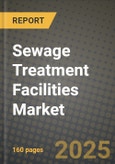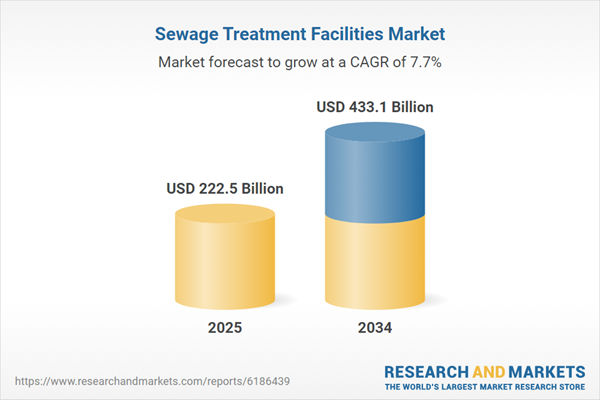The Sewage Treatment Facilities market plays a vital role in global water resource management, public health, and environmental sustainability. These facilities are responsible for the removal of contaminants from wastewater, making it safe for reuse or discharge into the environment. As urban populations grow and industrial activities expand, the demand for efficient and scalable sewage treatment solutions continues to rise. The market includes primary, secondary, and tertiary treatment technologies, with growing adoption of advanced treatment processes such as membrane filtration, UV disinfection, and biological nutrient removal. Regulatory mandates, water scarcity, and climate change concerns are prompting governments and municipalities to invest in modern sewage infrastructure and smart wastewater management systems. Moreover, public-private partnerships and international development funds are accelerating project implementations, especially in developing economies where sanitation infrastructure remains underdeveloped. The market is transitioning from basic sewage handling toward integrated, resource-recovering systems that support circular economy goals.
The sewage treatment facilities market saw a surge in upgrades and new facility development across multiple regions, driven by stricter environmental regulations and heightened awareness of waterborne disease risks. Developed countries focused on retrofitting aging infrastructure with energy-efficient technologies and IoT-based monitoring systems. Meanwhile, emerging economies like India, Brazil, and parts of Africa increased investments in decentralized treatment units to serve rapidly urbanizing areas. Smart sensors and AI-powered platforms were increasingly used for real-time monitoring, predictive maintenance, and optimization of treatment cycles. Governments launched initiatives to promote wastewater reuse in agriculture and industrial cooling, reducing pressure on freshwater sources. Several municipalities also explored sludge-to-energy conversion, converting biosolids into biogas for local power generation. Climate-resilient designs, such as flood-proof facilities and energy-independent treatment plants, gained importance as extreme weather events tested infrastructure reliability.
The sewage treatment facilities market is expected to evolve toward decentralized, digitally integrated, and environmentally regenerative models. Advanced biological treatment methods, including aerobic granular sludge and anaerobic digestion, will gain traction due to their lower energy footprints and potential for biogas recovery. Water-stressed regions will increasingly embrace treated wastewater for potable reuse, supported by stringent quality standards and public awareness campaigns. Governments will continue to incentivize investments in green infrastructure and nature-based solutions such as constructed wetlands. Digital twins, AI algorithms, and blockchain will improve operational transparency, reduce maintenance costs, and optimize system performance across large-scale facilities. Additionally, collaboration between utilities, technology providers, and private investors will be critical for scaling infrastructure in underserved areas. Despite the progress, challenges related to funding, aging infrastructure, and skills shortages in plant operations will require sustained attention to maintain momentum in global sewage treatment advancements.
Key Insights: Sewage Treatment Facilities Market
- Integration of IoT, AI, and digital twins is enhancing real-time monitoring, fault detection, and operational optimization in sewage treatment facilities.
- Decentralized treatment systems are gaining popularity in rural and peri-urban areas, providing localized wastewater solutions with lower installation costs.
- Growing adoption of resource recovery methods, such as energy generation from sludge and nutrient recovery for fertilizers, supports circular economy goals.
- Public-private partnerships are increasingly financing large-scale sewage treatment projects, particularly in emerging markets with infrastructure deficits.
- Water reuse for agriculture, industry, and even potable applications is becoming a strategic focus in water-scarce regions worldwide.
- Rising urbanization and industrialization are generating higher volumes of wastewater, driving demand for scalable sewage treatment infrastructure.
- Stringent environmental regulations and public health mandates are pushing municipalities to upgrade and expand treatment capacity.
- Government funding and international development assistance are supporting sewage treatment expansion in low- and middle-income countries.
- Technological advancements in filtration, biological processing, and automation are making sewage treatment more efficient and cost-effective.
- High capital and operational costs, coupled with limited technical expertise and infrastructure in certain regions, continue to hinder the implementation and maintenance of modern sewage treatment facilities, especially in rural and underserved urban areas.
Sewage Treatment Facilities Market Segmentation
By Type
- Residential
- Industrial
- and Commercial
By Treatment System
- Centralized
- Decentralized
By Application
- Industrial
- Municipal
Key Companies Analysed
- Kubota Corporation
- Hitachi Ltd.
- Suez S.A.
- SWA Water Treatment LLC
- Kingspan Water & Energy
- Xylem Inc.
- Pentair plc
- Ecolab Inc.
- Fluence Corporation Ltd.
- Thermax Limited
- Golder Associates Ltd.
- SFC Environmental Technologies Pvt. Ltd.
- Buckman Laboratories Inc.
- RWL Water Group plc
- Smith & Loveless Inc.
- Clearford Industries Inc.
- Aquatech International Corporation
- Evoqua Water Technologies LLC
- Hyflux Ltd.
- Veolia Environnement S.A.
- Orenco Systems Inc.
- Bio-Microbics Inc.
- Emerson Electric Company
- W.O.G. Technologies Pvt. Ltd.
- Ecoprog GmbH
- Membracon Ltd.
- Bluewater Bio Ltd.
- Premier Tech Aqua Systems India Pvt Ltd.
- BioShaft Water Technology Inc.
- Global Water & Energy L.L.C.
- H2O Innovation Inc.
Sewage Treatment Facilities Market Analytics
The report employs rigorous tools, including Porter’s Five Forces, value chain mapping, and scenario-based modeling, to assess supply-demand dynamics. Cross-sector influences from parent, derived, and substitute markets are evaluated to identify risks and opportunities. Trade and pricing analytics provide an up-to-date view of international flows, including leading exporters, importers, and regional price trends.Macroeconomic indicators, policy frameworks such as carbon pricing and energy security strategies, and evolving consumer behavior are considered in forecasting scenarios. Recent deal flows, partnerships, and technology innovations are incorporated to assess their impact on future market performance.
Sewage Treatment Facilities Market Competitive Intelligence
The competitive landscape is mapped through proprietary frameworks, profiling leading companies with details on business models, product portfolios, financial performance, and strategic initiatives. Key developments such as mergers & acquisitions, technology collaborations, investment inflows, and regional expansions are analyzed for their competitive impact. The report also identifies emerging players and innovative startups contributing to market disruption.Regional insights highlight the most promising investment destinations, regulatory landscapes, and evolving partnerships across energy and industrial corridors.
Countries Covered
- North America - Sewage Treatment Facilities market data and outlook to 2034
- United States
- Canada
- Mexico
- Europe - Sewage Treatment Facilities market data and outlook to 2034
- Germany
- United Kingdom
- France
- Italy
- Spain
- BeNeLux
- Russia
- Sweden
- Asia-Pacific - Sewage Treatment Facilities market data and outlook to 2034
- China
- Japan
- India
- South Korea
- Australia
- Indonesia
- Malaysia
- Vietnam
- Middle East and Africa - Sewage Treatment Facilities market data and outlook to 2034
- Saudi Arabia
- South Africa
- Iran
- UAE
- Egypt
- South and Central America - Sewage Treatment Facilities market data and outlook to 2034
- Brazil
- Argentina
- Chile
- Peru
Research Methodology
This study combines primary inputs from industry experts across the Sewage Treatment Facilities value chain with secondary data from associations, government publications, trade databases, and company disclosures. Proprietary modeling techniques, including data triangulation, statistical correlation, and scenario planning, are applied to deliver reliable market sizing and forecasting.Key Questions Addressed
- What is the current and forecast market size of the Sewage Treatment Facilities industry at global, regional, and country levels?
- Which types, applications, and technologies present the highest growth potential?
- How are supply chains adapting to geopolitical and economic shocks?
- What role do policy frameworks, trade flows, and sustainability targets play in shaping demand?
- Who are the leading players, and how are their strategies evolving in the face of global uncertainty?
- Which regional “hotspots” and customer segments will outpace the market, and what go-to-market and partnership models best support entry and expansion?
- Where are the most investable opportunities - across technology roadmaps, sustainability-linked innovation, and M&A - and what is the best segment to invest over the next 3-5 years?
Your Key Takeaways from the Sewage Treatment Facilities Market Report
- Global Sewage Treatment Facilities market size and growth projections (CAGR), 2024-2034
- Impact of Russia-Ukraine, Israel-Palestine, and Hamas conflicts on Sewage Treatment Facilities trade, costs, and supply chains
- Sewage Treatment Facilities market size, share, and outlook across 5 regions and 27 countries, 2023-2034
- Sewage Treatment Facilities market size, CAGR, and market share of key products, applications, and end-user verticals, 2023-2034
- Short- and long-term Sewage Treatment Facilities market trends, drivers, restraints, and opportunities
- Porter’s Five Forces analysis, technological developments, and Sewage Treatment Facilities supply chain analysis
- Sewage Treatment Facilities trade analysis, Sewage Treatment Facilities market price analysis, and Sewage Treatment Facilities supply/demand dynamics
- Profiles of 5 leading companies - overview, key strategies, financials, and products
- Latest Sewage Treatment Facilities market news and developments
Additional Support
With the purchase of this report, you will receive:- An updated PDF report and an MS Excel data workbook containing all market tables and figures for easy analysis.
- 7-day post-sale analyst support for clarifications and in-scope supplementary data, ensuring the deliverable aligns precisely with your requirements.
- Complimentary report update to incorporate the latest available data and the impact of recent market developments.
This product will be delivered within 1-3 business days.
Table of Contents
Companies Mentioned
- Kubota Corporation
- Hitachi Ltd.
- Suez S.A.
- SWA Water Treatment LLC
- Kingspan Water & Energy
- Xylem Inc.
- Pentair PLC
- Ecolab Inc.
- Fluence Corporation Ltd.
- Thermax Limited
- Golder Associates Ltd.
- SFC Environmental Technologies Pvt. Ltd.
- Buckman Laboratories Inc.
- RWL Water Group PLC
- Smith & Loveless Inc.
- Clearford Industries Inc.
- Aquatech International Corporation
- Evoqua Water Technologies LLC
- Hyflux Ltd.
- Veolia Environnement S.A.
- Orenco Systems Inc.
- Bio-Microbics Inc.
- Emerson Electric Company
- W.O.G. Technologies Pvt. Ltd.
- Ecoprog GmbH
- Membracon Ltd.
- Bluewater Bio Ltd.
- Premier Tech Aqua Systems India Pvt Ltd.
- BioShaft Water Technology Inc.
- Global Water & Energy L.L.C.
- H2O Innovation Inc.
Table Information
| Report Attribute | Details |
|---|---|
| No. of Pages | 160 |
| Published | October 2025 |
| Forecast Period | 2025 - 2034 |
| Estimated Market Value ( USD | $ 222.5 Billion |
| Forecasted Market Value ( USD | $ 433.1 Billion |
| Compound Annual Growth Rate | 7.6% |
| Regions Covered | Global |
| No. of Companies Mentioned | 31 |









